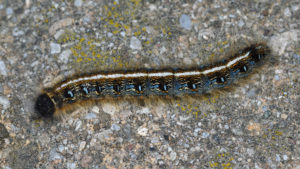Eastern Tent Caterpillar
go.ncsu.edu/readext?702186
en Español / em Português
El inglés es el idioma de control de esta página. En la medida en que haya algún conflicto entre la traducción al inglés y la traducción, el inglés prevalece.
Al hacer clic en el enlace de traducción se activa un servicio de traducción gratuito para convertir la página al español. Al igual que con cualquier traducción por Internet, la conversión no es sensible al contexto y puede que no traduzca el texto en su significado original. NC State Extension no garantiza la exactitud del texto traducido. Por favor, tenga en cuenta que algunas aplicaciones y/o servicios pueden no funcionar como se espera cuando se traducen.
Português
Inglês é o idioma de controle desta página. Na medida que haja algum conflito entre o texto original em Inglês e a tradução, o Inglês prevalece.
Ao clicar no link de tradução, um serviço gratuito de tradução será ativado para converter a página para o Português. Como em qualquer tradução pela internet, a conversão não é sensivel ao contexto e pode não ocorrer a tradução para o significado orginal. O serviço de Extensão da Carolina do Norte (NC State Extension) não garante a exatidão do texto traduzido. Por favor, observe que algumas funções ou serviços podem não funcionar como esperado após a tradução.
English
English is the controlling language of this page. To the extent there is any conflict between the English text and the translation, English controls.
Clicking on the translation link activates a free translation service to convert the page to Spanish. As with any Internet translation, the conversion is not context-sensitive and may not translate the text to its original meaning. NC State Extension does not guarantee the accuracy of the translated text. Please note that some applications and/or services may not function as expected when translated.
Collapse ▲Eastern tent caterpillars are common native insects that create silk webs or tents in the branch crotches of some tree species. Their favorite is rosacea species, such as cherry and apple. We’ve got reports this past week of tents which have become large and noticeable. The caterpillars become active much earlier in the spring.
Tent caterpillars have one generation per year. They overwinter as eggs glued to twigs of host trees. The egg cases look like gray foam wrapped around twigs. The eggs hatch in early spring usually around 50 Growing Degree Days and this typically will occur sometime in March. The caterpillars feed together and build a nest in crotches of trees. This helps distinguish them from Fall webworms which make tents later in the year at the ends of branches.
Eastern tent caterpillars often affect the same trees year after year. This is probably because they pupae in protected areas like woodpiles or under bark near the tree where they attached. They prefer cherry and apple trees so that when the female moths emerge in early summer they found the same trees to which to lay eggs.
Eastern tent caterpillars can defoliate small trees or trees with multiple tents. Even so, permanent damage to the tree health is unlikely the best management is to prune branches containing this to remove the caterpillars. In some cases, it is enough just to damage the tents with a pole so caterpillars fall to the ground and predators and birds can access the nest.
Insecticides are not typically necessary and are difficult to implement since the caterpillars spend much of their time in the waterproof tents. They consume leaves though so insecticides that kill caterpillars via consumption can be used. Look for insecticides that kill caterpillars synopsis and others in the Southeastern pest control guide for nursery and landscape plants. This is online at NCSU. Edu





